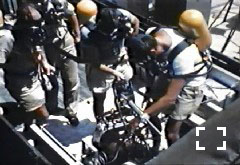 |
|
Operation Greenhouse - 1951

George 08/05/1951
|
Greenhouse was the third series of nuclear weapons tests in the Pacific Proving Grounds. It was conducted by the AEC from April to May of 1951. Four shots were conducted during Greenhouse, most of relatively high yield devices at the time. The development of the atomic bomb by the Soviet Union in 1949 spurred the United States to develop ever more powerful weapons. The main idea was to reduce the size, weight, and most importantly, reduce the amount of fissile material necessary for nuclear weapons, while increasing the destructive power.
President Truman authorized the development of the hydrogen bomb in January 1950. The thermonuclear project was lead by Professor Edward Teller, who, along with Professor Stanislaw Ulam, worked to design a two-stage hydrogen bomb.
The George device was purely experimental and unsuitable as a weapon. The test explosive device named the Cylinder consisted of a very large amount of highly enriched uranium (HEU) in its core, with an ordinary U238 tamper and a cylindrical HE implosion system. This device used a GE miniature betatron as an external neutron system (ENS) initiator to begin the fission chain reaction. External neutron initiators would later become standard in US stockpile weapons. The increase in initiation timing precision roughly doubling yields and allowing for user variable yields. The device was a disk about 244cm across and 60cm thick with a hole in its centre. At the end of the hole was a beryllium oxide sphere containing cryogenic deuterium and tritium gas (D-T).
The implosion generated sufficient heat and pressure for fusion reactions can occur. The thermal radiation arrived ahead of the shock front allowing time for a small amount of fusion reaction to occur before being consumed by the expanding fireball. The yield of the fusion reaction was estimated at ~25kt, negligible compared to the 200kt fission yield. The success of the fusion burn was observed by detecting the presence and intensity of characteristic "tell-tale" fingerprint of 14 MeV neutrons from the D+T fusion burn plasma. At 225 kilotons the test nearly tripled the yield of any nuclear device detonated up to that time.

Refilling the George D-T resevoir
|
The George experiment provided vital data needed for developing a true two-stage thermonuclear weapon, providing useful data on radiation implosion. The test validated principles which would be used for the first full-scale thermonuclear bomb test, Ivy Mike, one year later, on November 1, 1952, at Eniwetok Atoll.
Shots Dog and Easy were proof tests of the Mk-6 and Mk-5 bombs, respectively. Shot Item was the first boosted fission weapon, nearly doubling the normal yield of a similar non-boosted weapon. The boosting was achieved by placing a small amount of deuterium and tritium gas the center of the weapon pit. The compression of this material created a burst of fast neutrons, significantly increasing the amount of fission in the uranium-235. As well as increasing efficiency, these high energy neutrons caused "fast-fissioning" of the uranium-238 tamper further increasing yield.
All of the devices were mounted in large steel towers, to simulate air bursts. A number of target buildings, including bunkers, homes and factories were built on Mujinkarikku Islet to test nuclear weapon effects. A large number of Department of Defense personnel participated in these studies, about 10,500 in total. Joint Task Force 3 (JTF 3) coordinated and conducted Greenhouse. JTF 3 was a joint military and civilian organization.
The tests created signlficant downwind fallout on the islands of Japtan, Parry, and Enewetak. Enewetak was a base island where personnel from JTF 3 lived throughout the series. Japtan was an island used for recreation, but it also had an Army communication station and a Navy medical research unit. The fallout from shot Item, the last shot in this series, was much heavier than the first two. Personnel who remained on Enewetnk Island for 4 days after Item received over 2.45 R. Those who remained for 14 days recelved over 2.8 R. Most people, however, departed the test area within a week after the shot.
The amount of fallout received by the six ships involved in the tests varied with their locations and decontamination procedures. Nearly all crewmembers on five of these ships were assigned a fallout exposure immediately after Greenhouse, and these exposures were recorded in Navy medical records. The fallout exposure was lower aboard ship than on the islands due to water washdown and decontamlnation of external surfaces.
Pilots of the cloudtracking aircraft were issued neutral density goggles to prevent temporary flashblindness. Alrcraft crewmembers were required wear 22 kg of protective shielding, and to breathe 100-percent oxygen during and after sampling missions to reduce the possibility of inhaling radioactive particles.

| - DNA 6034F - Defense Nuclear Agency report - Greenhouse
|
|
|
|
 |





